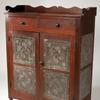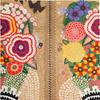'Bestowing Beauty: Masterpieces from Persian Lands' Brings Renowned Collection to Toledo
- March 28, 2022 13:37

This spring and summer the Toledo Museum of Art (TMA) in Ohio offers a spectacular exhibition of more than 100 objects drawn from one of the most significant private collections of Persian art. Bestowing Beauty: Masterpieces from Persian Lands opens April 23 and showcases the artistic inventiveness of Persian culture across different media, featuring a broad array of textiles, ceramics, metalwork, lacquer, paintings, jewelry and manuscripts from the Hossein Afshar Collection. Historically Persian lands – a wide swath of territory that at various times spanned from Cairo to Delhi, with its heart in what is now modern-day Iran – saw centuries of conquest and globalization. The art that resulted both reinforced Persian culture and assimilated these cross-cultural exchanges.

Woven throughout the stories of these extraordinary objects are experiences, ideas and emotions shared by cultures across the globe. By evoking universal themes of love, loss, conflict, and spirituality the exhibition brings to life the rich heritage and enduring beauty of Persian art.
“Celebrating the cultural heritage of Iran at the Toledo Museum of Art with Bestowing Beauty represents a rare opportunity for our audiences to experience the grandeur and beauty of these objects in person,” said Diane Wright, the Museum’s senior curator of glass and contemporary craft. “An important area of trade and migration, Persian lands served as critical centers of artistic production and influence for centuries, which the exhibition brilliantly highlights through these extraordinary works of art.”
The visual and literary arts have held a privileged place in Iranian civilization for centuries. The Hossein Afshar Collection, which embraces a diverse range of treasures from the eve of Islam’s arrival in the seventh century to the end of the 19th century, was assembled to preserve and share Persian art and culture today and for future generations. The exceptional objects in Bestowing Beauty embody the history of trade and migration found in Persian art, as well as map the legacy of artistic and technological advancements across the region. The exhibition is divided into six sections:
Banquets and Battles features the exuberance of palace feasting and fighting, quintessential aspects of Persian kingship and perennially popular subjects in Persian art and literature. Feasts are portrayed across media, such as a 19th-century painting of a female juggler accompanied by a cat, and the exhibition also includes lavishly decorated serving vessels and utensils fashioned from metals and ceramic.
Faith and Piety explores how, after the advent of Islam, words from the Qur’an became paramount as a mode of expression. Exquisitely penned and sumptuously illuminated Qur’an manuscripts were produced across the Islamic world. Calligraphers also copied a variety of texts in addition to the Qur’an, such as sayings from the Hadith, Shi‘a invocations, literary manuscripts and poetry, all of which are included in the exhibition.

Art of the Word, the third section, delves into the different developments, styles and uses of calligraphy, enhancing the aesthetic form and rhythmic beauty of calligraphy. Words were woven into textiles, engraved onto metalwork, painted on ceramic objects and enamels and carved into wood.
In Persian literature, love finds expression as a profound human connection and metaphor for a yearning for unity with the divine. Love and Longing traces how calligraphers and painters brought to life the rich corpus of Persian literature, from the exquisite miniature paintings from the Shahnama (“Book of Kings”), the Persian national epic, to couplets of lyric poetry and a pair of tightly embracing lovers on a slim lacquer pen case.

Kingship and Authority explores the kingly ideal, which figures prominently in Persian visual and literary culture. In addition to the Shahnama – the masterpiece that reflects the legends and virtues of Persian dynasties – court painters in the 19th century captured portraits of royalty and the ruling elite. This section also incorporates monumental silk carpets of the 16th and 17th centuries and an exquisite 19th-century pendant of gold, pearls and gemstones.
The concluding section, Earth and Nature, examines the manifestations of flora and fauna that abound in the art of Iran. Its people were among the earliest civilizations to cultivate gardens. The garden’s symbolism – of paradise, of the promise of spring, of renewal – permeated Persian culture and can be seen in the exhibition through glorious depictions of lions, falcons, nightingales, roses and fruit.
“The significance of Persian lands geographically, culturally and politically cannot be overstated,” said Sophie Ong, Hirsch curatorial fellow at the Toledo Museum of Art. “Bestowing Beauty draws attention to the splendor and complexity of Persian art, continuing TMA’s enrichment of the medieval world and beyond.”
The exhibition is accompanied by a hardcover, 304-page fully illustrated catalogue of the same title published by Yale University Press and edited by Aimée Froom, curator of arts of the Islamic world at the Museum of Fine Arts, Houston. The publication features color images of more than 100 objects from the Hossein Afshar Collection, and includes contributions from scholars Walter B. Denny, Melanie Gibson and David J. Roxburgh, who examine the meaning, artistry and influence of these distinctive and transcendent works of art.










100x100_c.jpg)







100x100_c.jpg)


